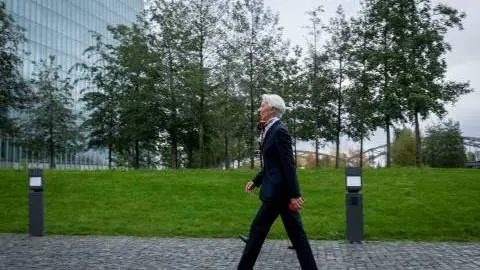To green or not to green: What it means for Credit if ECB becomes greener
The French central bank governor has urged the ECB to introduce a climate criteria for its corporate bond-buying program. We take a look at the varying options the central bank has to make climate consideration in monetary policy and what that would mean for credit markets
As it stands, the ECB holds 119 environmental, social and governance bonds under the corporate sector purchase programme (CSPP) and corporate purchases under the pandemic emergency purchase programme (PEPP). This accounts for roughly 7% of the ECB holdings.
But 60 of these bonds have been purchased after November 2019, accounting for roughly 10% of purchases since then. However, the ECB's eligible green bond universe is no more than 150 bonds thus far amounting to €122bn.
The French central bank governor, Francois Villeroy de Galhau recently said, “I propose to start decarbonising the ECB’s balance sheet in a pragmatic, gradual and targeted manner for all corporate assets”. In so calling for the ECB to tilt its purchases to limit issuers with poor climate performance. Villeroy acknowledged the proposed programme as “ambitious”, but we expect it, amongst other options, to be possible.
We break down some ‘options' available to the ECB and elaborate on the effects they could have on credit markets.
- Option 1: Concentrate (not exclusively) on purchasing green and high ESG scoring corporates going forward
- Option 2: Future purchases are no longer in carbon-intensive corporates
- Option 3: Actively sell carbon-intensive corporates
- Option 4. Actively sell low ESG scoring corporates or sectors
Very little ESG outperformance thus far

Concentrate (not exclusively) on purchasing green and high ESG scoring corporates going forward
This may already be an element of the ECB’s strategy as they own a very significant portion of the eligible green universe.
Particularly, over the past 12 months, whereby the ECB has increased their holdings of the green eligible universe from 50% to 80%. (i.e. they now own 115 out of 150 bonds) However, according to our sources purchasing green bonds by the ECB does not add any extra firepower in the size of purchases compared to grey.
Effect on credit: The effect on spreads would be marginal. We may see some outperformance of green and ESG, particularly in more volatile times, although this is also market-driven as seen in the chart above. Taking the past year as a proxy, green tends to be more stable in times of widening and volatility.
For future purchases, no longer invests in carbon intensive corporates
As it stands, the ECB currently hold 140 bonds from oil & gas companies.
While the oil & gas eligible universe amounts to around 150 bonds, this would limit the effect. Additionally, it would mean no further purchases of these bonds would be possible in the future in the secondary market.
Effect on credit: The effect on spreads would also be marginal, although more severe than Option 1 for new issues from these companies. As the ECB is clearly in favour of purchasing in the primary market, this would be a significant demand decrease for any carbon-intensive companies.
Actively sell carbon intensive corporates
Carbon intensive issuers will indeed see higher spreads if there is action taken by the ECB to not just limit but actively sell these issuers, but overall this will be a small impact on the cost for these corporates. Looking at the European oil & gas names, their cost of debt only represents a 0.5-1.5% of their total costs. On top of this, the most international oil & gas players issue bonds in other currencies and could still easily access capital markets less attentive to climate change issues.
Effect on credit: The effect on spreads would be very significant for all carbon-intensive corporates and very sudden. Spreads would widen across the curve creating a large differential between green companies and ‘dirty’ companies. The severity of this option would lead to significant market distortion. With the market herd mentality already moving towards ESG, if the ECB join the herd the real green/ sustainable investors may begin to be crowded out.
Actively sell low ESG scoring corporates or sectors
Utilising ESG scoring system to dictate whether a company should be bought, held or sold by the ECB would certainly be the most drastic option. Indeed, carbon intensive corporates would have very low ESG scoring, as would sectors such as metals & mining, chemicals, autos and even the commodity food and agri sector.
Effect on credit: The effect on spreads would be substantial. We would see a nuclear reaction with the creation of a large differential between high ESG and low ESG scoring companies and sectors. We would, therefore, expect to see this as a catalyst for a permanent change in classifying valuations in credit markets.
This could then become as much of an important driver as ratings.
But there are some limitations
Having said all of that, there are some limits to how far the ECB can really go.
For instance, eligible supply is expected to fall significantly. Already we are forecasting lower supply of €350bn in 2021. However, within this we expect reverse yankee supply to increase up to €80bn and corporate hybrid supply to reach at least €50bn if not more. This leaves roughly just over €200bn in eligible debt supplied this year, a large decrease relative to last year which saw closer to €330bn of eligible supply.
If the ECB were to begin selling either carbon-intensive corporates or lower ESG scored companies, it would likely create an aggressive sell off in credit markets as a whole. Ultimately causing a permanent change in classifying valuations in credit markets. As mentioned. this could then become as much of an important driver as ratings.
Sometimes, things are easier said than done. The various options laid out indeed have benefits from an environmental perspective, but what does that mean for markets.
We remain sceptical about what the ECB can do in relation to green investments. The ECB, according to their own report, is the largest catalyst for the creation of the green bonds market, however, even after four years, only 7% of their portfolio is green. Therefore, we would like to see more from the ECB in terms of action for promoting green.
Going forward, we expect the most likely option will be to concentrate (not exclusively) on purchasing green and high ESG scoring corporates, with potentially the introduction of no longer investing in carbon-intensive corporates down the line. Actively selling either carbon-intensive corporates or low ESG scoring corporates remain unlikely options.
Safe to say, the more severe the option the more drastic the effect on credit markets will be. As it stands, the ESG market is in a slight limbo as the supply-demand balance is off, meaning there is a lot of inconsistencies in terms of the greenium - the premium for green bonds, where ESG curves trade relative to grey. Continuing down the path of focusing on purchasing more green and high ESG is unlikely to balance the ESG market.
In adding the no longer investing in carbon-intensive corporates option, the greenium will start being introduced and it will act as a catalyst, particularly in times of volatility or a bearish outlook.
Example of good ESG scored companies
Example of poor ESG scored companies
This publication has been prepared by ING solely for information purposes irrespective of a particular user's means, financial situation or investment objectives. The information does not constitute investment recommendation, and nor is it investment, legal or tax advice or an offer or solicitation to purchase or sell any financial instrument. Read more
Download
Download article
15 February 2021
How green was my credit? This bundle contains 7 Articles
